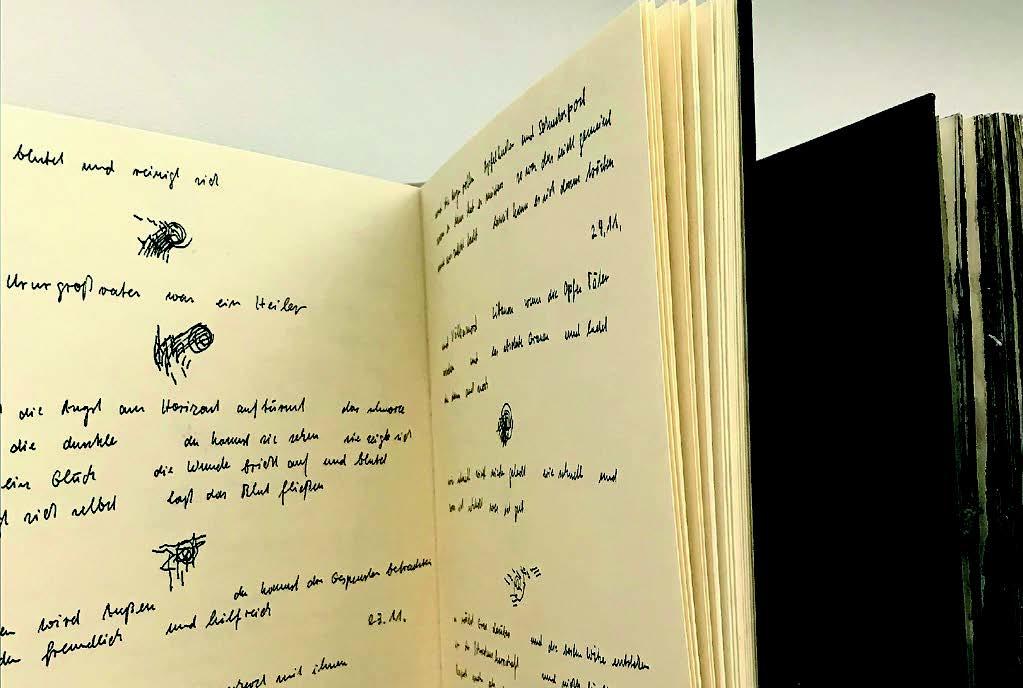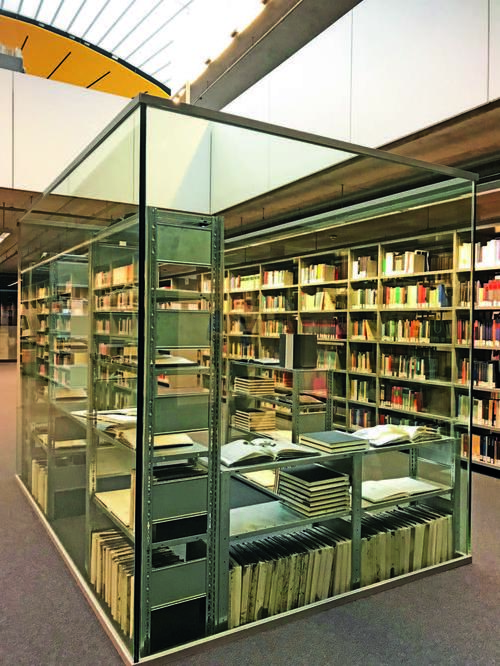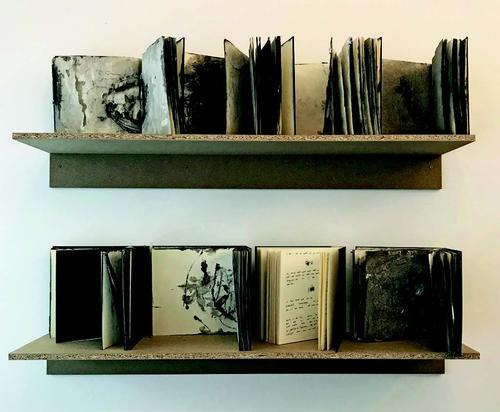Li Silberberg
Li Silberberg Installation
Image Credit: Semjon H. N. Semjon
Li Silberberg 2
Image Credit: Semjon H. N. Semjon
Life – Inscribed and Rubbed into Paper
Library by Li Silberberg
The essential characteristic of a book are its bound pages, which have been folded in advance as printing sheets, placed on top of each other, sewed and glued in order to experience the freedom of skimming through its individual pages. The spine that is sewed to its pages holds the book together and, with the aid of the book cover, provides stability and makes the newly created fit for everyday use.
Blank books are mostly artist books, or sketch books. But also as diaries or idea books they offer space for personal experience and knowledge that can be referred to in the future, since they are handwritten. Only in the process of describing and designating (or due to its content materialized through the printing process) the book receives its soul. Before, it represents this potential possibility as an industrial, inexpensive product in well-sorted art supply stores.
For 22 years Li Silberberg has been working daily on a series of artist books which have become her private library that comprises two types of books: Her sketch books as the collection of ideas and daily documented thoughts (like a diary), an accumulation of phrases set in a row block by which the dated days can be distinguished also visually. And then, in between – not on every page – the almost rhythmical presence of the handmade block of ideas is visually interrupted by a small, abstract, structural yet emblematic drawing (called Spirals of Life).*
These daily entries are the preparation for the actual work, but are indispensably related to the main and proud work of the Library, meanwhile comprising 181 volumes. The precisely described and categorized sketch books amount to 40. Capturing thoughts and ideas interspersed with conceptual sketches may be conceived as an act of reflection/ contem-plation, which comes to a second creative level in the following: thoughts – and with these the actual situation – are inscribed or rubbed with bare hands into the paper surface, once in their purest naked condition and immediacy of finger skin and the blank paper sheets, and once covered with a mantle of ink rubbed into the surface of the sheet.
Li Silberberg is stroking with her bare hands over the pages of an open book in manifold orientations: dozens, hundreds, thousands of times. Inscribing the present condition and memory of the past are accomplished with her eyes closed, with the artist sitting in cross-legged position on a yoga-cushion. Li Silberberg considers this prolonged act of creation her daily meditation routine, immersing herself into her book, her carrier of knowledge and experience to be charged, while keeping constant (skin) contact. Her ‘centre of production’ reminds of a small meditation room.

The old adage says that time is a great healer. With Li Silberberg it is the other way round. Her time of actively describing and rubbing brings about wounds, not necessarily at her fingertips, as might be expected, which are clean and sound, full of tension and seismic tenderness, despite all this rubbing and daily ink baths. It is her books that contain her wounds. They are ground up, the sheets are worn and cut open in horizontal direction, giving way for another sequence of rubbing and writing on the underlying pages. Thus, a three-dimensional structure is created with fissures and worked, wafer-thin edges; and depending on their inner condition and state of a day’s work the next pages are turned in order to be filled with life energy in the course of a day or week. The thickness of these books bears witness to the working intensity of the past weeks; approximately six are needed for the transcription of a phase of life within one volume, which has grown double in size through the treatment of the individual pages. The carefully manufactured industrial product of a sketchbook (see above) is made to withstand the physical hardships of the treatment. The linen spine of the book stained with ink bears witness to the intensity of this inscription process, as an écriture automatique humaine, as well as its shortcomings, as this writing is not done by a machine but by the artist Li Silberberg, whose profession luckily includes imperfection, just like with every human being.
This way, a private library is created over months and years – counting 22 in the meantime – speaking of the life of Li Silberberg without permitting the concrete to be deciphered. The idea leaves us alone with ourselves. Reminiscent of the Sisyphean labour, it represents the materialized energy of life, created in a meditative process over a period of 40.000 hours.
The public library which will, one day, give this corpus a new home as ‘library within a library’ can count itself lucky to present this gesamtkunstwerk to visitors and users of the library as a metaphor developed during one’s lifetime for the acquisition, transfer and retention of knowledge, as an efficacious metaphor for the ‘soul of the house’. This artwork is only for sale to a public library. Please contact gallery for further informations.
Semjon H. N. Semjon
March 2020
- These idea books are the result of the ‘classical’ sketchbooks from the 1970 ‒ 1990ies, filled with fascinating drawings characterized by a spirit of abstract structuralism. Nimble and confident in their lines they are animated as a whole – vibrant.
One or another of these sketchbooks really needs to be preserved in facsimile.


